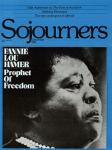Unpredictability is a mark of life in Central America. While natural disasters such as earthquakes, floods, and droughts have sporadically visited great tragedy on the region, political rifts and extremes have created a perpetual state of agony.
The only predictable factor in Central American politics is that the unpredictable is always around the corner. Governments are toppled, new regimes are installed. But one constant remains in this region in which power in the extreme is wielded without conscience: the grinding poverty of the people.
El Salvador is torn by civil war, massacres of Guatemala's Indian population are on the rise under the reign of its "born-again" dictator, and Honduras is beginning to exhibit the signs of increased repression in the form of torture and "disappearances." Despite power shifts, barbaric militaries have maintained an upper hand throughout the area.
On July 19, 1979, there was reason to hope in Central America. A people's struggle rid Nicaragua of a 45-year dynasty of terror and atrocity under the Somoza family. A brutal dictator was gone, and the people took their liberation into their own hands. They planted new crops, learned to read, improved their medical care. They had inherited chaos, and they had begun to change it.
For many people around the world, Nicaragua has been a sign. They have wanted the Nicaraguan experiment to work. They have applauded its improvements, grieved its mistakes, and held on to hope.
Nicaragua is trying to be a light. Like any candle, it sputters sometimes. And sometimes it fears the darkness around it.
Those fears are justified. There is a darkness that is cutting the candle off at the base, making it shorter and shorter and threatening to come down from above to extinguish it entirely.
America's "secret war" is no longer a secret. The November 8 issue of Newsweek details extensive covert operations being carried out by the U.S. government against Nicaragua. Something between honest diplomacy and war, these operations are designed to destabilize the country's Sandinista government. Plans call for a $19.9 million, 500-man U.S.-trained paramilitary force to be located at the Nicaragua-Honduras border.
The U.S. ambassador in Honduras, John Negroponte, is overseeing a campaign being carried out by 50 CIA personnel. Their tasks include training Honduran security forces in intelligence and interrogation, providing logistical support for raids into Nicaragua, and training anti-Sandinista Nicaraguans in sabotage operations. Many of these Nicaraguans are former National Guardsmen, supporters and comrades of the brutal Somoza. A number of their friends are receiving counter-revolutionary training in Miami, Florida.
Congress has approved $21 million of U.S. money for improving three Honduran military bases for U.S. use "in case of an emergency." And, though postponed for at least a month because of Reagan's upcoming trip to Costa Rica, joint U.S.-Honduran military maneuvers on a scale unprecedented in Honduran history are being planned to take place near the Nicaraguan border.
The U.S. campaign is an exceptional display of hypocrisy and warmongering. While much has been made of religious freedom and church-state tensions in Nicaragua, no word has been issued from the U.S. government about lack of religious freedom in Guatemala or El Salvador, where dozens of priests have been murdered by government security forces. While accusing the Soviet Union and Cuba of intervention in Central America and decrying arms shipments to El Salvador (we are still waiting for the evidence), the Reagan administration is perpetuating massive interference in a legitimate government and plotting its demise.
It is pumping arms, advisers, and military aid into a region already beset by violence of the most demonic sort. And in doing so, it is exacerbating tensions between Honduras and Nicaragua, between the Nicaraguan government and the Miskito Indians in the border region, and between the Honduran government and its people. It is risking an all-out regional war while destroying any hopes for peace.
Ignoring overtures from Nicaragua to engage in negotiations, the Reagan administration is cutting off political options. Its hope is that the covert operations will be successful at undermining the Nicaraguan government so as to prevent drawing the U.S. into an unpopular war.
The fear of invasion is running high in Nicaragua. A delegation of 12 representatives from U.S. peace organizations which recently returned from the country stated that war between Nicaragua and Honduras, with U.S. blessing, is a strong possibility.
Perhaps there is another predictable element in Central American politics: that the U.S. government will always choose the wrong side. As was shown in its overthrow of reform-minded governments in Chile and Guatemala(of historical note is the fact that Honduras also served as the base of operations for the latter), no amount of human suffering is considered too great when U.S. interests are at stake.
When shortsightedness and hypocrisy are the bedrock of foreign policy, we can expect to count the casualties. Let us hope that we in the churches find a voice with which to raise our strongest opposition.
Joyce Hollyday was an associate editor of Sojourners when this article appeared.

Got something to say about what you're reading? We value your feedback!
